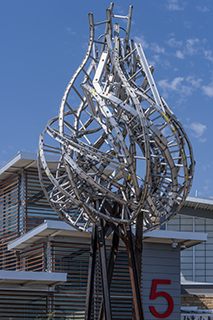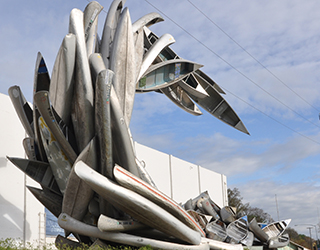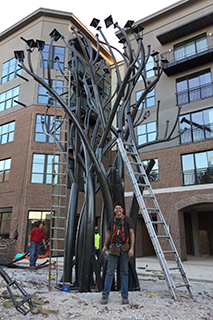College of Engineering News Room
Alum uses Engineering to Create Public Art
By Brad Stager
Whether on display as a flaming spire constructed of rescue ladders in Clearwater or a wave made of used canoes in Lewiston, Idaho, Christopher Fennell’s creativity combines engineering skills and artistic talent to create assembled sculptures that are on public display in communities across the country.
After graduating from the College of Engineering with his BSME in 1989, Fennell found work in the field as a robotics and flight simulation engineer, earning a reputation for his visualization and modeling skills at companies like Motorola and Reflectone.

“What I realized is, I had a lot of crazy ideas and I became the engineer that would solve things that no one else could solve because they needed a crazy idea,” says Fennell.
While engineering was earning Fennell a solid living, he had an urge to try something different. As it turns out, Fennell says a big attraction for going into public art sculpting ultimately proved to be a change in his workplace environment.
“Later on, I realized I just liked being outside a lot, but I didn’t figure that out until grad school at the University of Georgia,” says Fennell, who earned his MFA in Sculpture at UGA, after receiving his BA in Sculpture from USF.
Fennell primarily produces art for public spaces, often on behalf of small or mid-size cities investing in their community's culture, or planned housing developments wanting to make a similar commitment to residents. The large size of his sculptures and their placement in locations where people gather offers him opportunities to affect public perception on a grand scale.

“I like building things you can walk through and things that can stand on their own to transport people to another space and another reality,” says Fennell. “If you can get them to go inside something, immediately they’re in your world and so to work on that scale I found I really need cities to pay for it.”
Engineering and sculpting might seem like very distinct vocations, but Fennell has carved a niche for himself by working at the intersection of the two that exists within him.
“I can do both and most people don’t have both sides of their mind to where they can do that,” says Fennell, who adds that his engineering knowledge provides a solid foundation upon which to build his creations.
“I realize that a lot of engineering is problem solving and the way you problem-solve anything is you gotta think outside the box, and at the end you have to make a connection.”
The connections that Fennell makes led to sculptures such as the Bicycle Tornado, a funnel of contorted bicycles in Athens, Georgia, or in a case of art performing a public function, a working bus shelter constructed of recycled car windows called Window Tree in Creve Coeur, Missouri. He abides by a couple of basic principles to guide his creative process.
“I’m trying to make artwork like a popular song, with the idea that everyone can look at it and understand what it is,” says Fennell, who cites a project for a subdivision, “It is a bird out of birdhouses, they look at it and they know what it is.” He adds that viewers get a payoff by exploring his work. “They look at it a little closer and they go ‘He’s making the idea that the birdhouses are like a subdivision and that we all live in this place, a community made of little things that are different but they go together as this whole.’”
As for implementing his visions, Fennell says he follows the rule of keeping things simple, and avoiding unnecessary complications.
“I approach every art problem as if it were an engineering problem. I write down all the variables, where it’s going to go on the site, what is the history, how much money do I have, it has to last out there for 25, 50 years with very little maintenance and a three-year-old has to be able to look at it and tell me what it is.”
Working onsite in the communities where his sculptures are installed for periods of up to a few months provides Fennell with information and local perspectives to produce works relevant to residents. It also makes it convenient to solicit raw materials such as used canoes, mailboxes, dock wood, shovels, bird houses, ladders and even old school buses. Fennell’s work demonstrates a commitment to recycling and sustainability that help his projects garner the support of local code enforcement boards as well as arts councils.

“If I see an object that’s been used before, it has more power,” says Fennell.
“For Canoe Wave, I have canoes that have stickers on them so it reminds people that was a canoe that went down the river.”
Fennell’s Canoe Wave resembles a cresting wave and is made of 50 used canoes that were donated or purchased from owners and stands on the east bank of the Snake River in Lewiston. Its riverside appeal has even earned it a role in the independent film, The River Thief.
There are also several of Fennell’s sculptures located throughout the Tampa Bay area, including his Ladder Fire, a single flame made of decommissioned aluminum fire ladders that rises outside of Fire Station 48 in Clearwater.
“It is a memorial for firefighters and it was the city of Clearwater’s first public art piece, so they wanted something contemporary,” says Fennell. “I like working with objects people recognize, put into a fantastic situation. What you’re seeing in my work is the artist and the engineer having a debate about how to do that.”
You can learn more about Fennell’s sculptures and see photographs of them on his website or Facebook.